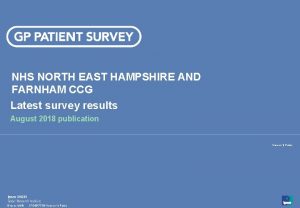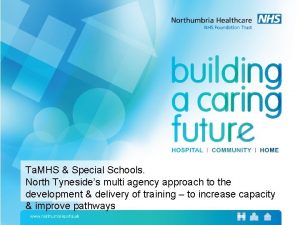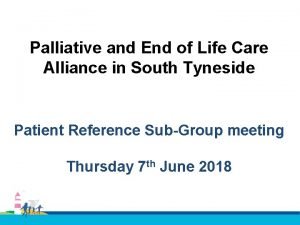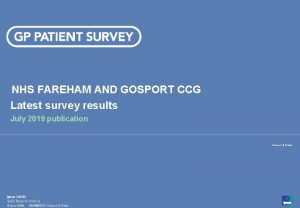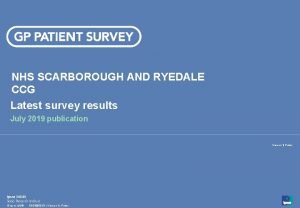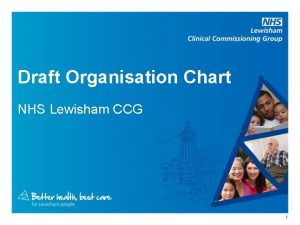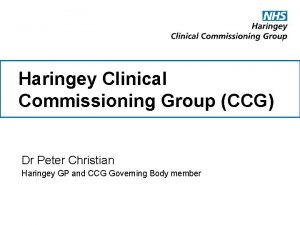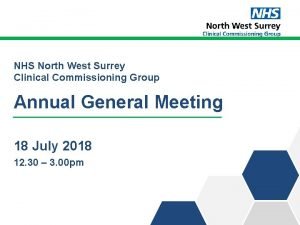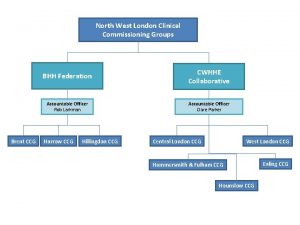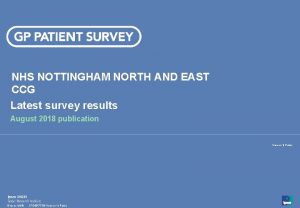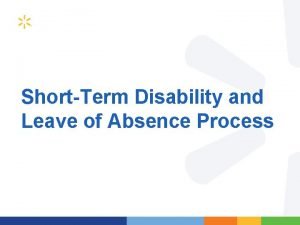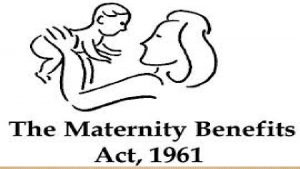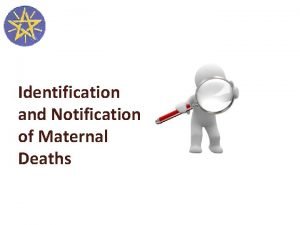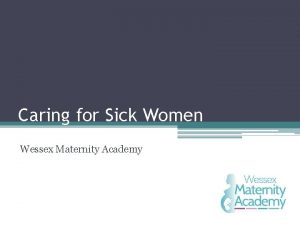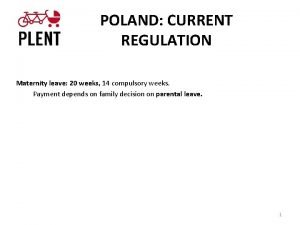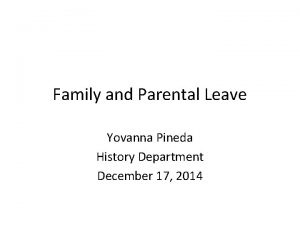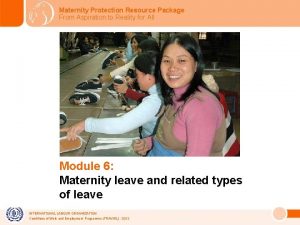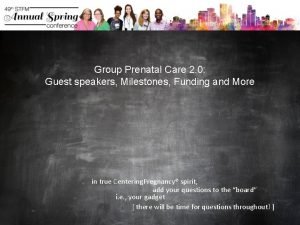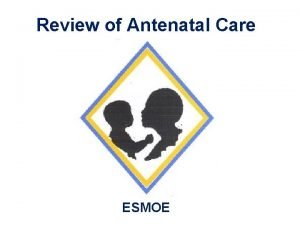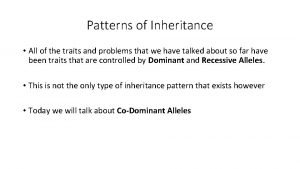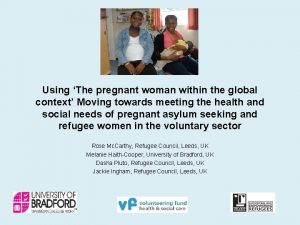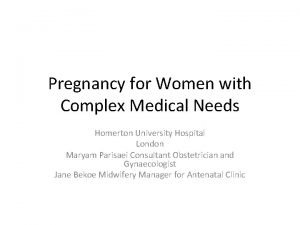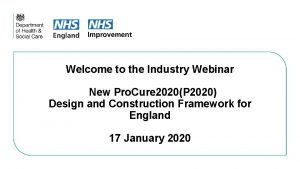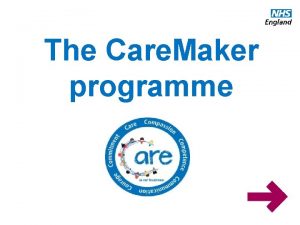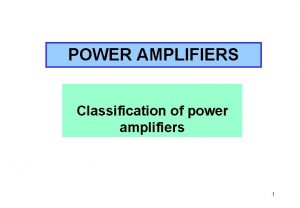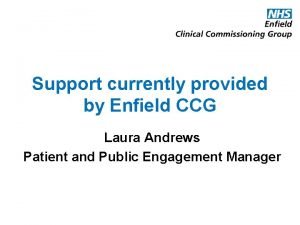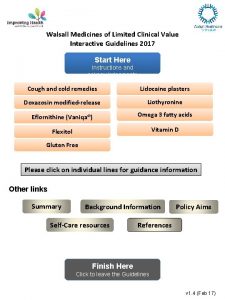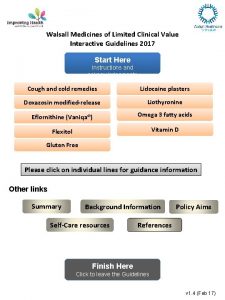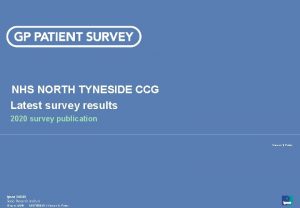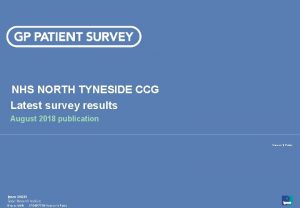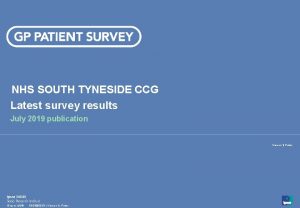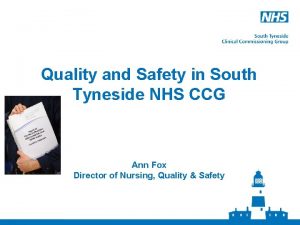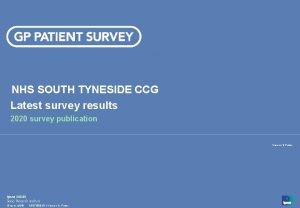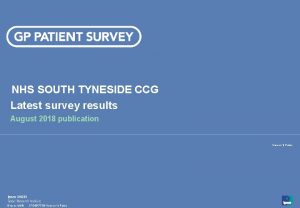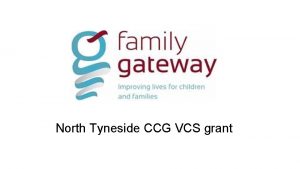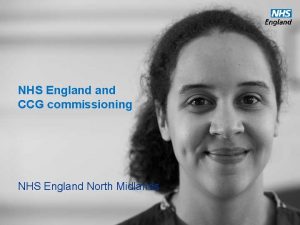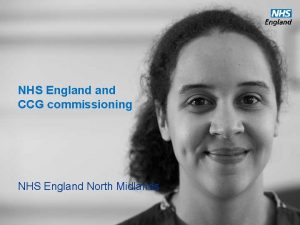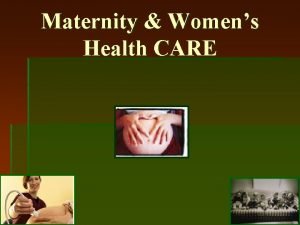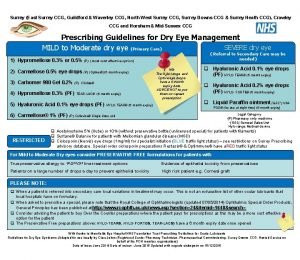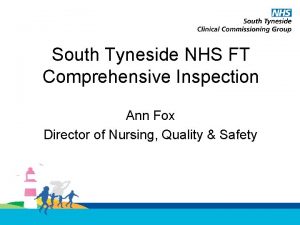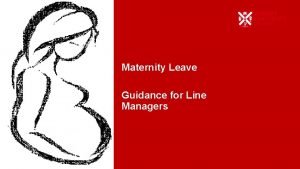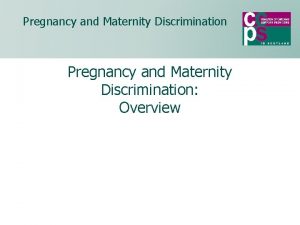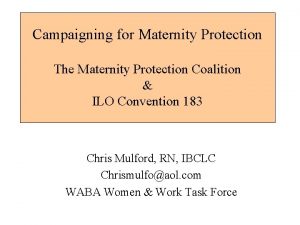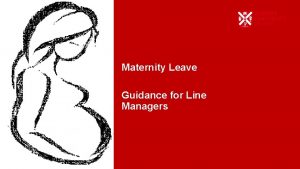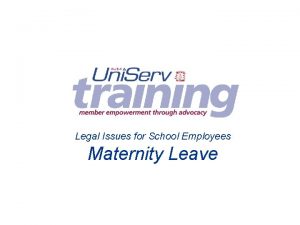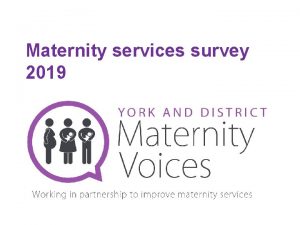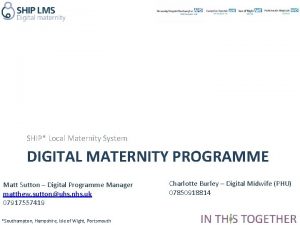NHS North Tyneside CCG Maternity care research Delivered























































- Slides: 55

NHS North Tyneside CCG Maternity care research Delivered by Joanne Loughlin-Ridley September 2013

Project background This section of the report provides detail on the research objectives, methodology and sample, providing context behind the insight.

Project background • Explain was commissioned in early 2012 by NHS North of Tyne to carry out a comprehensive evaluation of maternity care services across the North East • The research detailed within this report aimed to build upon the qualitative insight that was completed and delivered to NHS North of Tyne in April 2012 • An on-street survey was commissioned by NHS North Tyneside CCG, to engage a random sample of local ‘mothers’ and ‘future mothers’ – ‘Mothers’ includes women whose youngest child is five years or younger, and ‘future mothers’ includes pregnant women and those without children that plan to have a family of their own in the future – Quotas / targets were set for the survey sample based on age using the most up to date birth data available publically • Fieldwork took place across a four week period, ending in early September 2013. Alongside the on-street approach, researchers were able to flexibly attend relevant sessions at local children’s centers as a means to gain access to the eligible target audience

Project background • As with any data collection where a sample is drawn to represent a population, there is a potential difference between the response from the sample and the true situation in the population as a whole (a census). This is known as a standard error which is estimated using statistical calculations based on the sample size and the population size, normally expressed as a confidence interval for the results • To achieve 100% accuracy in results would require the entire population to participate (a census). The usual confidence interval used in market research is 95% which means that you can be confident that in 19 out of 20 instances the actual population behaviour will be within the confidence interval range. The table below gives an indication of the 95% confidence interval for the data within this report at different sample sizes Sample size • • 95% Confidence Interval Sample: 1100 ± 3. 0 Sample: 600 ± 4. 0 Sample: 500 ± 4. 4 Sub-Sample: 100 ± 9. 8 Sub-Sample: 70 ± 11. 7 For example, if a result was 50% we can be confident that the true result if a census was completed for an 1100 sample survey would be actually ± 3. 0 (therefore between 47% - 53%) Please also note that respondents that did not or could not answer a question were removed from the data and therefore the base size in charts fluctuates from question to question

Project background • 1, 145 took part in the on-street survey, including 595 mothers and 553 future mothers 96% 97% 96% 62% 58% 49% 46% 26% 44% 38% 42% 65% 35% 26% 7% 16 -19 6% 20 -29 Age Overall (1144) 30+ White - UK ABC 1 Ethnicity Future mothers (552) C 2 DE Socio-economic group Mothers (592) • 4% of mothers and future mothers indicated they suffered a long-term illness / disability • 7% of future mothers were pregnant at the point of interview • 46% of mothers had only one child, meaning 54% were ‘multiple mothers’ • 75% of mothers had a youngest child under 24 months,

Project background • Whilst a target was set for an equal proportion of interviews to be carried out across the four areas within North Tyneside, researchers found it challenging to locate eligible women to take part in the North West area specifically 37% 34% 26% 11% 27% 32% 29% 30% 28% 24% 12% North West North East South West Area of residence Overall (1139 -1145) • Future mothers (551 -553) Mothers (588 -592) Analysis has revealed interesting variations in response when comparing residents from the West (North West and South West) to the East (North East and South East) and so throughout this report comparisons are made on this basis

Antenatal care Within this section of the report you will find details as to the quantitative insight generated from the mothers research which focused on antenatal care. Please note that future mothers were not asked questions relating to antenatal care on the basis that previous insight had confirmed a lack of knowledge and therefore expectations.

Antenatal care • The majority of mothers had experienced their most recent antenatal care in North Tyneside 63% 35% 3% Newcastle North Tyneside Northumberland Where antenatal care had been previously experienced (Mothers overall 593) • • Mothers were asked to indicate in their own words, the ONE thing that could have been changed about their antenatal care experience that would have made it better Nothing /unsure (306 = 52%) More appointments (39 = 7%) More information (28 = 5%) Attitude of staff (22 = 4%) More hospital checks/scans (21 = 4%) More support/advice (15 = 3%) Closer to home (13 = 2%) See same midwife (13 = 2%) Unprompted there was no evidence of a consistent area to improve and no significant variation found between care in Newcastle, North Tyneside and Northumberland

Antenatal care ‘A consistent midwife throughout pregnancy’ ‘Better staff, as they are not very friendly’ ‘More information in early stages and more check ups’ ‘Every time I tried to discuss the birthing plan it was put off’ ‘It would have been better to stay at North Tyneside as I was taken from hospital to hospital’ ‘For someone to see me close to home’ ‘More classes throughout pregnancy, start them at an earlier stage of pregnancy’ ‘Have more scans when you have complications’ Nothing /unsure (306 = 52%) More appointments (39 = 7%) More information (28 = 5%) Attitude of staff (22 = 4%) More hospital checks/scans (21 = 4%) More support/advice (15 = 3%) Closer to home (13 = 2%) See same midwife (13 = 2%)

Antenatal care A series of statements were given to mothers for them to rate their level of agreement using a scale of 1 to 10 (1 was ‘Strongly disagree’ and 10 was ‘Strongly agree’) Antenatal care (mothers overall 591) • I want my midwif e. . . 9, 350000001 I want to have acce. . . 9, 32 I want routin e chec. . . I want my partne r to. . . I want opport unities to. . . • 8, 96 7, 73 7, 63 No significant variations were found by age, socio-economic group, number of children or where previous experience of antenatal care had been

Antenatal care • When comparing responses from mothers that lived in the West to those that lived in the Strongly agreed (10 out of 10) East, across three of the statements shown below there was significant variation found with mothers in the West more likely to ‘strongly agree’ and give 10 out of 10 I want my midwif e appoin tmen. . . 72% 84% 65% I want to have access to advic. . . 74% 80% 70% I want routine checks to be carried out b. . . 66% 75% 60% Mothers overall (591) *significant variations are circled in the graph West (234) East (357)

Antenatal care • Mothers were then asked to indicate from a showcard, which of the following were MOST and LEAST important to them overall in regards to antenatal care 50% 47% 37% 29% 18% 6% 2% 5% 3% 3% Seeing the same midwife at For midwife appointments to Access to advice 24 hours a Having opportunities to meet Partners being given advice each routine check be carried out in the local day by telephone other mothers and information to help them community, e. g. GP surgery, prepare children's centres Level of importance Most important (591) Least important (589) • With the exception of mothers aged 16 -19, all profiles rated ‘Partners being given advice and information to help them prepare’ to be the LEAST important overall – Least important to 16 -19 s was ‘Having opportunities to meet other mothers’ (48%)

Antenatal care • Variation in response was found for four of the statements rated in terms of what was MOST and LEAST important, when comparing responses by the area of residence and the number of children mothers had 55% 47% 45% 50% 48% 43% 50% 44% 42% 30% 29% 33% 32% 47% 41% 40% 37% 36% 35% 52% 45% 53% 44% 35% 28% 24% 20% Seeing the same midwife at each routine check For midwife appointments to be carried out in the local community, e. g. GP surgery, children's centres Having opportunities to meet other mothers MOST important Partners being given advice and information to help them prepare LEAST important Mothers overall (589 -591) West (232 -234) East (357) Multiple mothers (317 -319) ABC 1 (205) C 2 DE (380 -382) First time mothers (271)

Labour and delivery care Within this section of the report you will find details as to the quantitative insight generated from the mothers and future mothers research which focused on labour and delivery care. Please note that the sample of mothers and future mothers has also been combined within this section to give indications of trends by profile on a large sample base of over 1, 100.

Labour and delivery care • The majority of mothers had experienced their most recent labour and delivery care in Newcastle 63% 25% 13% Newcastle North Tyneside Northumberland Where labour and delivery care had been received previously (Mothers overall 593) • Mothers were asked to indicate in their own words, the ONE thing that could have been changed about their labour and delivery care experience that would have made it better Nothing / unsure (268 = 45%) Early admittance (21 = 4%) Attitude of staff / communication (60 = 10%) Pain relief choice / administration (22 = 4%) More midwives (33 = 6%) Same midwife (14 = 2%) Facilities / hospital policies (24 = 4%) Closer to home (12 = 2%) Caesarean (10 = 2%) • Unprompted there was no evidence of a consistent area to improve • Those that had their care in Northumberland were more likely to state ‘Closer to home’

Labour and delivery care ‘I would prefer a private room next time’ ‘Nicer midwives, they have bad manners’ ‘The same midwife throughout labour’ ‘You shouldn't be sent home when your waters have broke’ ‘More staff to assist you to be more supportive’ Attitude of staff / communication (60 = 10%) Pain relief choice / administration (22 = 4%) ‘I would rather have been closer to home than going to Wansbeck’ ‘Same midwife, I had 3 different ones’ ‘The staff didn't care about me they just left me to get on with it’ Nothing / unsure (268 = 45%) Early admittance (21 = 4%) ‘Give me more time to give birth instead of getting a C section’ ‘Not to be sent home when in labour’ ‘Have more pain relief ’ More midwives (33 = 6%) Same midwife (14 = 2%) Facilities / hospital policies (24 = 4%) Closer to home (12 = 2%) Caesarean (10 = 2%)

Labour and delivery care A series of statements were given to mothers and future mothers for them to rate their level of agreement using a scale of 1 to 10 (1 was ‘Strongly disagree’ and 10 was ‘Strongly agree’) I. . . 9, 56 9, 48 I. . . Labour and delivery care (overall 1135 -1143) • 9, 18 I. . . 9, 05 I. . . 8, 98 I. . . 8, 91 I. . . 8, 84 I. . . 8, 31 I. . . 8, 15 I. . . 7, 85 I. . . 7, 70 I. . . 7, 59 I. . . 7, 43 I. . . 7, 20 I. . . 7, 04 6, 10

Labour and delivery care • Across ten of the statements there was variation evident between mothers and future mothers in terms of the proportion that ‘strongly agreed’ and gave 10 out of 10 I want my. . . 60% I wa. . . 62% Strongly agree (10 out 0 f 10) I wa. . . 62% 49% 43% I wa. . . 56% 49% 43% 45% I wa. . . 37% I wa. . . 31% I wa. . . Overall (1135 -1143) 49% 52% 40% 43% 36% Mothers (584 -591) 66% 71% 66% 51% 40% 66% 57% 48% I wa. . . *significant variations are circled in the graph 63% 43% Future mothers (550 -552)

Labour and delivery care • Across six of the statements there was also variation evident between mothers and future mothers in terms of the proportion that ‘strongly disagreed’ and gave 1 out of 10 Strongly disagree (1 out 0 f 10) I want my birth. . . 3% 1% I want to be sho. . . I want my part. . . 5% 7% 11% 3% I want one to one. . . 11% 7% I want to be in a. . . 8% 11% 9% Overall (1135 -1143) *significant variations are circled in the graph 11% 5% I want opport uniti. . . Mothers (584 -591) 14% Future mothers (550 -552) 14%

Labour and delivery care • Across 11 of the statements a significantly higher proportion of mothers living in the West ‘strongly agreed’ and gave 10 out of 10 82% I. . . 77% 82% I. . . 78% 73% I. . . 70% Strongly agree (10 out of 10) I. . . 63% 73% 56% 68% I. . . 75% 64% 66% I. . . 62% 57% I. . . 53% 49% I. . . 44% 49% I. . . 42% 73% 64% 55% 58% 42% 46% 40% Overall (1135 -1143) *significant variations are circled in the graph 78% 65% I. . . 80% 68% West (455 -458) East (679 -684) 89% 88%

Labour and delivery care • Across five of the statements there was variation found in terms of the proportion that ‘strongly agreed’ and gave 10 out of 10, when looking at the response of mothers in terms of where they had most recently experienced labour and delivery care 82% 71% 64% 60% 48% 46% 45% 74% 82% 82% 73% 68% 86% 77% 75% 61% 55% 51% 33% I want to be in a service during I want my care to be led by a early labour instead of waiting midwife at home to progress I want the same midwife to I want all options for pain relief I want doctors and specialists care for me throughout my available should I need them or on-hand in the same building labour and delivery change my mind should I need them Strongly agree (10 out 0 f 10) Mothers (589 -591) Previous experience in North Tyneside (145) *significant variations are circled in the graph Previous experience in Newcastle (369 -371) Previous experience in Northumberland (79)

Labour and delivery care • Across four of the statements a trend was found whereby the younger the respondent, the higher the proportion that ‘strongly agreed’ and gave 10 out of 10 Strongly agree (10 out of 10) I want my birthin g partne r to. . . 66% 71% 67% 60% I want to be shown how to care for. . . 57% 67% 56% 48% I want my partne r to be shown how. . . 51% 57% 53% 39% I want opport unities to meet othe. . . 36% 40% 37% 31% Overall (1135 -1143) *significant variations are circled in the graph 16 -19 (295) 20 -29 (551 -554) 30+ (292 -293)

Labour and delivery care • Across six of the statements there was variation found by socio-economic group in terms of the proportion rating ‘strongly agree’ and giving 10 out of 10 I want the service to fe. . . 70% 66% 72% Strongly agree (10 out of 10) I want my partne r to. . . 51% 55% 48% I want one to one supp. . . 49% 54% 46% I want access to free car. . . 49% 53% 46% I want access to dedi. . . 42% 48% 39% I want opport unities to. . . 36% 40% 34% Overall (1135 -1143) *significant variations are circled in the graph ABC 1 (432 -434) C 2 DE (7698 -701)

Labour and delivery care • Across six of the statements variation was found by area of residence, age and socioeconomic group in terms of the proportion that ‘strongly disagree’ and gave 1 out of 10 16% 14% 11% 7% 12% 13% 9% 8% 13% 10% 13% 11% 10% 9% 6% 11% 10% 8% 7% 5% 11% 8% 7% 6% 13% 12% 11% 10% 8% 7% 7% 8% I want one to one support with breastfeeding in the service 8% 7% 8% 8% 8% 7% 6% 3% I want my partner to be I want to be shown how to care for baby, e. g. bathing, nappies, dressing Strongly disagree (1 out of 10) Overall (1135 -1143) 16 -19 (293) 20 -29 (551 -554) 30+ (291 -293) West (457) East (680) ABC 1 (430 -436) C 2 DE (701) *significant variations are circled in the graph 7%7% 5% 2% I want opportunities to I want to stay in a service I want to be in a service meet other mothers, e. g. for a number of days during early labour communcal kitchen, TV after giving birth instead of waiting at room home to progress 10%

Most important (1137) in g e th Level of importance Least important (1127) d te ca g 12% kin ar g kin 0% rp ca . . 1% ee rp ar ca rg iv. fte 8% Fr ty ni 14% er u. . . 4% 2% at sa g di n . . g. . m fe e e. om st. g. C ay fd rs , e ro be m nu m he ot ea br y, g. . . 1%2% di ra fo m ith w o. in th Ba ba b g. e. . . a. om ro lu di ng in c he rt fo by , ba rg e, th ba lik e l 2%1% De ice re ca e th pp or t su to th er e to ee m rv se to on w ho fo r ha su ite n oo gp in 1% in es to n e ca r en ha rt he 1% 2% ay e On w sh o to il d isc nt ith w lr at 7% St be w ho yu st a om ro bl e la ai . l. . 2%1% ni ti rtu to n w to te rth Bi av 0% 2% Op po er rtn Pa ho gs er tn ar ee yf el ns he 1% in iva ah om io ife . . in. . . bu ild w id ut t ho ug e m ti. ai w m ha n by a sa th ro e th fo pt lie re e ca r in ed gl rt he 15% Be Pr ve ha n ai e ov id ll p ga pr d an on -h in be at 0% ng p to to vin Ha ife w id ts re 0% hi ice m lis ia ec ur r bo la Ca rly ea 12% Bi rt rv se e m sa sp in 5% Th e vic e er as nd sa or ct n in gi • Do ay St Labour and delivery care Mothers and future mothers were then asked to indicate from a showcard, which of the following were MOST and LEAST important overall in regards to labour and delivery care 33% 32% 22% 11% 5% 0% 1%

Labour and delivery care • Variation in response was found for six of the statements rated in terms of what was MOST and LEAST important, when comparing responses by age and area of residence 32% 25% 22% 15% 17% 12% 11% 8% 9% 26% 25% 21% 20% 35% 34% 32% 20% 16% 8% 12% 10% 9% 7% 7% 5% 5% 6% 9% 8% 4% 13%13% 5% 9% 6% Staying in a service in early Birthing partner to stay Staying in the service for a Opportunities to meet labour rather than waiting until discharge, including number of days after other mothers, e. g. at home to progress overnight giving birth Communcal kitchen, TV room MOST important Overall 1127 -1137) *significant variations are circled in the graph Birthing pool Free car parking LEAST important 16 -19 (292) 20 -29 (545 -552) 30+ (290 -293) West (451 -457) East (675 -679)

Labour and delivery care • Following a description of what it would mean to give birth at home, in a midwifery led unit, a maternity care unit and a birthing centre, mothers and future mothers were asked to indicate which option they would choose if giving birth in the future 67% 61% 55% 9% 6% 11% Home 15% 13% 17% Midwifery led unit 16% Maternity care unit 15% 17% Birthing centre Choice of birth place Overall (1123) Future mothers (542) Mothers (581) • First time mothers were more likely than multiple mothers to opt for a ‘Birthing centre’ (21% V 13%), and were less likely to select ‘Home’ (8% V 13%) • Respondents from the West were more likely to opt for a ‘Birthing centre’ (21% V 12%) *significant variations are circled in the graph

Labour and delivery care • When asked to explain the reason for their choice, the following themes were found Home (95 = 9% overall) Comfortable / relaxing (63 = 66%) Family to be there (15 = 16%) Don’t like hospitals (7 = 7%) Midwifery led unit (169 = 15% overall) Maternity care unit (682 = 61% overall) Birthing centre (177 = 16% overall) Level of care / staff (51 = 30%) Clinical staff on-hand (189 = 28%) Atmosphere (53 = 30%) Homely / relaxed (42 = 25%) Facilities (28 = 17%) Just ‘in case’ (185 = 27%) Facilities (120 = 18%) Pain relief (97 = 14%) Facilities (23 = 13%) Just ‘in case’ (22 = 12%) Previous experience (21 = 12%) Previous experience (20 = 12%) No choice (risk) (46 = 7%) Convenience (4 = 4%) Closer to home (21 = 12%) Previous experience (30 = 4%) No intervention (3 = 3%) Recommended (10 = 6%) Convenience (13 = 2%) Partner can stay (7 = 4%) Recommendation (10 = 1%) Private (4 = 2%) The ‘norm’ (8 = 1%) Recommendation (3 = 2%) Previous experience (2 = 2%) Level of care / staff (18 = 10%) Natural (8 = 5%)

Labour and delivery care • When asked to explain the reason for their choice, the following themes were found Home (95 = 9% overall) Comfortable / relaxing (63 = 66%) Midwifery led unit (169 = 15% overall) Maternity care unit (682 = 61% overall) Birthing centre (177 = 16% overall) Level of care / staff (51 = 30%) Clinical staff on-hand (189 = 28%) Atmosphere (53 = 30%) Homely / relaxed (42 = 25%) ‘It will be more comfortable at home’ ‘I would feel more comfortable having family with me’ ‘It is more relaxed at home’ ‘It was comfortable and has brilliant staff, it wasn't like a cattle market’ ‘There is more one to one support’ ‘They are more caring’ ‘It has a homely feel and a nicer environment’ Just ‘in case’ (185 = 27%) ‘I would feel safer’ ‘There are doctors on duty’ ‘There are doctors there ’ ‘In case something goes wrong ’ ‘It has a more relaxed atmosphere and it is more like home’ ‘It is more natural and homely’ ‘It is a more relaxing place’

Labour and delivery care • When asked why they would not choose the other options, the following themes were found Not a home birth (1028 = 92%) Not a midwifery led unit (954 = 85%) Not a maternity care unit (441 = 39% ) Not a birthing centre (946 = 84% ) Just ‘in case’ (448 = 44%) Pain relief (266 = 28%) Dislike hospitals (98 = 22%) Unsure (192= 20%) No clinicians (92 = 9%) No clinicians (161 = 17%) Unsure (90 = 20%) No clinicians (90 = 10%) Pain relief (73 = 7%) Transfer (80 = 8%) Too busy (86 = 20%) Transfer (51 = 5%) Unsure (80 = 8%) Dislike hospitals (45 = 5%) Impersonal care (39 = 9%) Pain relief (50 = 5%) Scared (62 = 6%) Facilities / equipment (45 = 5%) Not 1 st choice (32 = 7%) Couldn’t (40 = 4%) Unnecessary (21 = 5%) Just ‘in case’ (38 = 4%) Too far away (16 = 4%) Messy (60 = 6%) Couldn’t (40 = 4%) No equipment (36 = 4%) Prefer hospital (27 = 3%) Inconvenient (35 = 3%) Not 1 st choice (16 = 2%) Transfer time (32 = 3%) One to one care (11 = 1%) Not sterile (31 = 3%) Negative (31 = 3%) Prefer hospital (30 = 3%) Unfamiliar (39 = 4%) Not 1 st choice (18 = 2%) Facilities (27 = 3%) Just ‘in case’ (18 = 2%) Dislike hospitals (39 = 4%) Too far away (17 = 2%) Couldn’t (22 = 2%)

Labour and delivery care • When asked why they would not choose the other options, the following themes were found Not a home birth (1028 = 92%) Just ‘in case’ (448 = 44%) ‘In case things went wrong’ ‘In case of any complications’ ‘I would be scared things would go wrong ’ ‘I don't think it is as safe ’ Not a midwifery led unit (954 = 85%) Not a maternity care unit (441 = 39% ) Not a birthing centre (946 = 84% ) Pain relief (266 = 28%) Dislike hospitals (98 = 22%) Unsure (192= 20%) No clinicians (161 = 17%) Unsure (90 = 20%) No clinicians (90 = 10%) Too busy (86 = 20%) ‘There are no doctors ’ ‘It is too busy’ ‘The staff are not experienced enough’ ‘Not enough medical back up staff if needed’ ‘It is a hospital environment’ ‘There are no doctors there’ ‘There is not enough pain relief’ ‘It is too busy it is like a cattle market ’ ‘There is no doctor on duty, would not feel as safe’ ‘Limited pain control’ ‘There are not as many medical staff ’ ‘No reason’ ‘It is too clinical ’ ‘No reason’

Labour and delivery care • When provided with a list of current options in the North East, the RVI’s maternity care unit was found to be most preferable by both mothers and future mothers 49% 54% 43% 22% 21% 22% 15% 7% 6% Home 9% 6% 4% 18% 13% 7% 2% 2% 1% Midwifery led unit - Maternity care unit - Birthing centre - RVI, Rake Lane, North Wansbeck, Ashington RVI, Newcastle Cramlington (due to Newcastle Shields open in 2015) Specific choice of birth place Overall (1141) Future mothers (551) Mothers (590) • First time mothers were more likely than multiple mothers to opt for ‘Birthing centre – RVI’ (21% V 15%) • There was no significant variation found by age when comparing responses *significant variations are circled in the graph

Labour and delivery care • When comparing choice of service type by the location of the mothers most recent experience of labour and delivery care, variation was found 55% 60% 57% 50% 29% 23% 11% 9% 12% 13% 23% 17% 11% 8% Home Midwifery led unit Maternity care unit 4% Birthing centre Choice of birth place Mothers overall (581) Previous experience in Newcastle (363) Previous experience in North Tyneside (145) Previous experience in Northumberland (77) • Mothers that most recently experienced labour and delivery care in North Tyneside were more likely to opt for a ‘Midwifery led unit’ and were less likely to opt for a ‘Maternity care unit’ • Mothers that most recently experienced labour and delivery care in Newcastle, were more likely to opt for a ‘Birthing Centre’ *significant variations are circled in the graph

Labour and delivery care • Comparing response by area of residence and socio-economic group revealed variation 56% 49% 22% 51% 46% 43% 27% 25% 20% 15% 13% 7% 8% 7% 6% 8% 9% 6% 7% 5% 2% 1% Home Midwifery led unit Rake Lane, North Shields Maternity care unit Wansbeck, Ashington 17% 14% 12% Maternity care unit RVI, Newcastle Maternity care unit Cramlington (due to open in 2015) Birthing centre - RVI, Newcastle Specific choice of birth place Overall (1141) *significant variations are circled in the graph West (458) East (664) ABC 1 (435) C 2 DE (701)

Labour and delivery care • When asked why they had chosen that specific option, the following themes were found RVI, maternity care unit (553 = 49%) Rake Lane, midwifery led unit (248 = 22%) RVI, birthing centre (172 = 15%) Home (83 = 7%) Wansbeck, maternity care unit (67 = 6%) Cramlington, maternity care unit (17 = 2%) Good reputation / better than others (85 = 15%) Specialists / doctors on -hand (56 = 10%) Close to home (137 = 55%) Big / good hospital (55 = 10%) Good reputation (15 = 9%) Family can be there (9 = 11%) Close to home (14 = 21% It’s a new unit (10 = 59%) Close to home (9 = 53% Previous experience / familiarity (55 = 10%) Only birthing centre (11 = 6%) Comfortable / relaxing (68 = 82%) Previous experience / familiarity (42 = 63% Quality of care (40 = 7%) Safer (26 = 5%) Recommendation (12 = 5%) Clinicians nearby (16 = 9%) Past experience / familiarity (24 = 14%) Close to home (54 = 10%) Atmosphere (29 = 12%) Quality of care (41 = 17%) Past experience / familiarity (47 = 19%) Atmosphere (35 = 20%) Facilities (67 = 12%) Clinicians onhand (6 = 9% Reputation / better than others (10 = 15% Close to home (9 = 5%) Quality of care (10 = 6%) Partners can stay (3 = 2%)

Labour and delivery care • When asked why they had chosen that specific option, the following themes were found RVI, maternity care unit (553 = 49%) Rake Lane, midwifery led unit (248 = 22%) RVI, birthing centre (172 = 15%) Home (83 = 7%) Wansbeck, maternity care unit (67 = 6%) Cramlington, maternity care unit (17 = 2%) Good reputation / better than others (85 = 15%) Specialists / doctors on -hand (56 = 10%) Facilities (67 = 12%) Big / good hospital (55 = 10%) ‘Family had their babies there, they say it's good and it has a better reputation’ Close to home (54 = 10%) Quality of care (40 = 7%) Previous experience / familiarity (55 = 10%) Safer (26 = 5%) ‘Rake lane has a bad reputation’ ‘It is a better hospital overall’ ‘Excellent after care’ ‘They have excellent staff’ ‘It is a bigger hospital’ ‘There are doctors on hand if needed’ ‘I had a good experience the first time’ ‘Has everything on hand’ ‘It has got all the things you need’ ‘It is the closest maternity care hospital’ ‘I would feel safe’ ‘It is the best option’

Labour and delivery care • The maternity care unit at the RVI was also most preferred for mothers and future mothers, should they need to stay within a service for several days following delivery 61% 64% 58% 20% 20% 7% Midwifery led unit - Rake Lane, North Shields 5% 9% 3% Maternity care unit Wansbeck, Ashington Maternity care unit - RVI, Newcastle 4% 3% Maternity care unit Cramlington (due to open in 2015) 8% 7% 9% Birthing centre - RVI, Newcastle Choice of aftercare, if required to stay in a service Overall (1141) Future mothers (553) Mothers (588) • First time mothers were more likely than multiple mothers to opt for ‘Birthing centre – RVI’ (12% V 7%), whilst being less likely to opt for ‘Maternity care unit – RVI’ (53% V 63%) • There was no significant variation found by age or SEG when comparing responses *significant variations are circled in the graph

Labour and delivery care • When comparing specific choice of service by the location of the mothers most recent experience of labour and delivery care, variation was found 56% 48% 43% 34% 27% 25% 22% 9% 8% 10% 11% 24% 18% 11% 8% 7% 2% Home Midwifery led unit Rake Lane, North Shields 18% Maternity care unit Wansbeck, Ashington 1% 0% 1% Maternity care unit RVI, Newcastle 8% 5% Maternity care unit Cramlington (due to open in 2015) 5% Birthing centre - RVI, Newcastle Specific choice of birth place Mothers (590) Previous experience in Newcastle (371) Previous experience in North Tyneside (144) Previous experience in Northumberland (79) • Mothers that most recently experienced labour and delivery care in North Tyneside were more likely to opt for ‘Rake Lane’ • Mothers that most recently experienced labour and delivery care in Newcastle, were more likely to opt for a ‘RVI – maternity’ and ‘RVI – birthing centre’ • Mothers that most recently experienced labour and delivery care in Northumberland, were more likely to opt for ‘Wansbeck’ *significant variations are circled in the graph

Labour and delivery care • There was variation evidence in choice of service when comparing responses by area of residence 69% 61% 56% 24% 20% 14% 7% Midwifery led unit - Rake Lane, North Shields 11% 3% 2% Maternity care unit Wansbeck, Ashington 3% 8% 3% Maternity care unit - RVI, Maternity care unit Newcastle Cramlington (due to open in 2015) 12% 6% Birthing centre - RVI, Newcastle Choice of aftercare, if required to stay in a service Overall (1141) West (458) East (682) • Significantly more respondents living in the East opted for ‘Rake Lane’ and ‘Wansbeck’ • Significantly more respondents living in the West opted for the ‘RVI’ (maternity care unit and birthing centre) *significant variations are circled in the graph

Labour and delivery care • When asked why they had chosen that specific option, the following themes were found RVI, maternity care unit (694 = 61%) Rake Lane, midwifery led unit (229 = 20%) RVI, birthing centre (94 = 8%) Specialists / doctors onhand (188 = 27%) Good reputation / better than others (150 = 22%) Close to home (149 = 60%) Facilities (144 = 21%) Close to home (84 = 12%) Previous experience / familiarity (68 = 10%) Previous experience / familiarity (27 = 11%) Atmosphere (39 = 16%) Quality of care (27 = 11%) Facilities (14 = 6%) Atmosphere (35 = 37%) Quality of care (14 = 15%) Only birthing centre (8 = 9%) Clinicians nearby (26 = 28%) Good reputation (8 = 9%) Wansbeck, maternity care unit (83 = 7%) Previous experience / familiarity (18 = 22%) Cramlington, maternity care unit (35 = 3%) Specialists / doctors on-hand (16= 46%) Close to home (16 = 19%) Close to home (7 = 20%) Specialists / doctors on-hand (12= 14%) Quality of care (14 = 17%) It’s a new unit (4 = 11%) Atmosphere (14 = 17%) Atmosphere (6 = 1%) Quality of care (57 = 8%)

Labour and delivery care • When asked why they had chosen that specific option, the following themes were found RVI, maternity care unit (694 = 61%) Rake Lane, midwifery led unit (229 = 20%) RVI, birthing centre (94 = 8%) Wansbeck, maternity care unit (83 = 7%) Cramlington, maternity care unit (35 = 3%) Specialists / doctors onhand (188 = 27%) Good reputation / better than others (150 = 22%) ‘There are more specialist staff ‘It is a better hospital ’ Facilities (144 = 21%) Close to home (84 = 12%) Previous experience / familiarity (68 = 10%) Atmosphere (6 = 1%) Quality of care (57 = 8%) ‘It has everything you need ’ ‘They have everything there’ ‘It has the best reputation ’ ‘There are more doctors there ’ ‘There are specialists on hand’

Postnatal care Within this section of the report you will find details as to the quantitative insight generated from the mothers research which focused on postnatal care. Please note that future mothers were not asked questions relating to postnatal care on the basis that previous insight had confirmed a lack of knowledge and therefore expectations.

Postnatal care • The majority of mothers had experienced their most recent postnatal care in North Tyneside 66% 31% 4% Newcastle North Tyneside Northumberland Where postnatal care had been received previously (Mothers overall 593) • • Mothers were asked to indicate in their own words, the ONE thing that could have been changed about their postnatal care experience that would have made it better Nothing / unsure (293 = 49%) More advice/ support/information (56 = 9%) Earlier follow-ups / longer visits (51 = 9%) Staff attitude / training (24 = 4%) Same midwife / health visitor (23 = 4%) Hospital policies (21 = 4%) Unprompted there was no evidence of a consistent area to improve and no significant variation found between care in Newcastle, North Tyneside and Northumberland

Postnatal care ‘To see the same midwife each time would be better’ ‘Midwife to be more caring after I got home’ ‘Help with breast feeding’ ‘At the RVI I didn't like being on ward, I could not relax’ ‘For the midwives to be more pleasant and to give more hands on help’ ‘For my partner to be able to stay with me longer after the baby is born’ ‘I was left on my own, there was no space in Rake Lane for me, more help with breastfeeding’ ‘More health visits after you get home’ ‘To see the midwife for a longer period of time at home’ ‘Friendly midwife where you can feel comfortable with them as they are the same one’ ‘Just being allowed visitors anytime’ Nothing / unsure (293 = 49%) More advice/ support/information (56 = 9%) Earlier follow-ups / longer visits (51 = 9%) Staff attitude / training (24 = 4%) Same midwife / health visitor (23 = 4%) Hospital policies (21 = 4%) ‘To be more aware of where I can get help after the birth’

Postnatal care • A series of statements were given to mothers for them to rate their level of agreement using a scale of 1 to 10 (1 was ‘Strongly disagree’ and 10 was ‘Strongly agree’) Postnatal care (mothers overall 589 -592) After hom. . . • 9, 36 I want to. . . 9, 13 I want the. . . 9, 08 I want one. . . I want my. . . 7, 37 6, 92 I want grou. . . 6, 74 I want opp. . . 6, 72 There was no significant variations found by age or where the mothers had previously experienced postnatal care from

Postnatal care • Across five of the statements variation was found by area of residence, socio-economic group and number of children mothers had, in terms of the proportion that ‘strongly agreed’ and gave 10 out of 10 83% 73% 66% 38% 34%34%34% 30% 31% 40% 36%38%35% 32% 34% 68% 65%66% 64% 61% 71%71%71%71% 63% 49% 50% 51% 44% 41% 39% 40% I want group support with I want my partner to be given I want one to one support with I want the same health After home visits stop I want breastfeeding where I can meet advice and information to help breastfeeding professional to visit my home appointments to be carried out other mothers them care for the baby for routine checks each time within the local community such as baby weigh-in clinics Strongly agree (10 out of 10) Mothers overall (589 -592) West (232 -234) *significant variations are circled in the graph East (356 -358) First time mothers (270 -272) Multiple mothers (317 -319) ABC 1 (205) C 2 DE (380 -383)

Postnatal care Across five of the statements variation was found by area of residence, socio-economic group • and number of children mothers had, in terms of the proportion that ‘strongly disagreed’ and gave 1 out of 10 20% 17% 14% 17% 17% 13% 11% 20% 13% 14% 15% 10% I want opportunities to meet other mothers 17% 15% 14% 12% 11% I want group support with I want my partner to be given advice breastfeeding where I can meet other and information to help them care for mothers the baby 17% 12% 10% 9% I want one to one support with breastfeeding Strongly disagree (1 out of 10) Mothers overall (590 -592) West (232 -234) East (356 -358) First time mothers (270 -272) Multiple mothers (317 -319) ABC 1 (204 -205) C 2 DE (380 -383) *significant variations are circled in the graph

Postnatal care • Mothers were then asked to indicate from a showcard, which of the following were MOST and LEAST important to them overall in regards to antenatal care 41% 36% 25% 24% 15% 12% 10% 8% 4% 17% 1% 2% 2% 2% Seeing the same For appointments One to one support Group support with Access to advice 24 Having opportunities Partners being given professional at each such as baby weigh-in with breastfeeding where hours a day by to meet other advice and home visit clinics to be carried you meet other telephone mothers information to help out in the local mothers them care for the community after baby home visits stop Level of importance Most important (589) • Least important (587) With the exception of mothers living in the West, all profiles rated ‘Partners being given advice and information to help them care for the baby’ to be the LEAST important overall – Least important to mothers from the West was ‘Having opportunities to meet other mothers’ (30%)

Postnatal care • Comparing results of MOST important, there were interesting variations found by area of residence and socio-economic group when looking at three statements in particular 46% 43% 41% 38% 31% 27% 24% 19% 15% 16% 12% 9% 7% Seeing the same professional at each home visit For appointments such as baby weigh-in clinics to be carried out in the local community after home visits stop One to one support with breastfeeding MOST important Mothers overall (589) *significant variations are circled in the graph West (233) East (356) ABC 1 (205) C 2 DE (380)

Postnatal care • Comparing results of LEAST important, there were interesting variations found by area of residence and the number of children mothers had, across four statements 42% 36% 30% 25% 26% 25% 22% 40% 33% 28% 22% 18% 15% 10% 8% 8% 13% 10% 9% 5% One to one support with breastfeeding Group support with breastfeeding Having opportunities to meet other where you meet other mothers Partners being given advice and information to help them care for the baby LEAST important Mothers overall (587) *significant variations are circled in the graph West (232) East (355) First time mothers (270) Multiple mothers (316)

Next steps Based on the quantitative insight, Explain has developed within this section of the report key considerations and recommendations for NHS North Tyneside CCG, to inform plans for the future.

Key considerations High levels of agreement were found across the maternity care journey in regards to what local women want from services (top five overall are displayed in the graph below) Labour and delivery care - I want doctors and specialists on-hand in the same building should I need them 9, 56 Labour and delivery care - I want all options for pain relief available should I need them or change my mind Postnatal care - After home visits stop I want appointments to be carried out within the local community such as baby weigh-in clinics Antenatal Care - I want my midwife appointments to be carried out in the local community Postnatal care - I want to have access to advice 24 hours a day by telephone 9, 48 9, 36 9, 350000001 9, 13 Whilst many mothers indicated ‘nothing’ could be improved about their experience, when looking across the whole of the maternity care journey, the most common theme in the literal comments collected calls for consistency in seeing the same health professional

Key considerations When asked to indicate what was MOST important, consistency in seeing the same health professional for antenatal and postnatal care stood out overall (top three shown below) Antenatal care Seeing the same midwife. . . 47% Postnatal care Seeing the same professi. . . Labour and delivery care Doctors. . . 41% 33% Revealed as the LEAST important overall was ‘Partners being given advice and information to help them prepare’ in regards to antenatal care (50%), followed by postnatal care (36%)

Key considerations A majority of 61% would opt for a maternity care unit in the future, with high ratings given to statements regarding ‘doctors and specialists’ as well as ‘pain relief’ Most mothers (63%) had experienced labour and delivery care in Newcastle, a trend that is anticipated to continue with 64% overall opting for the RVI if giving birth in the future The RVI was found to have a strong and positive reputation, notably very popular with residents of the West as well as future mothers Variations found by demographic profiles as well as by location, confirm that a ‘truly ideal’ maternity care service would require a high level of flexibility and tailoring to the individual

 Nhs north east hampshire and farnham ccg
Nhs north east hampshire and farnham ccg Pshe nedir
Pshe nedir End of life care in south tyneside
End of life care in south tyneside Nhs guildford and waverley ccg
Nhs guildford and waverley ccg Nhs fareham and gosport ccg
Nhs fareham and gosport ccg Nhs wyre forest ccg
Nhs wyre forest ccg Nhs scarborough and ryedale ccg
Nhs scarborough and ryedale ccg Diana braithwaite nhs
Diana braithwaite nhs Nhs luton ccg
Nhs luton ccg Dr peter christian
Dr peter christian North west surrey ccg
North west surrey ccg North west london ccg
North west london ccg Nottingham north and east ccg
Nottingham north and east ccg South tyneside pcn
South tyneside pcn North east and north cumbria integrated care system
North east and north cumbria integrated care system Walmart sedgwick maternity leave
Walmart sedgwick maternity leave Ar leaves and passes
Ar leaves and passes Legislation related to maternity benefits
Legislation related to maternity benefits Objectives of maternity ward
Objectives of maternity ward Wessex maternity academy
Wessex maternity academy Maternity leave poland
Maternity leave poland Oews score
Oews score Ut austin maternity leave
Ut austin maternity leave Why is maternity leave important
Why is maternity leave important Maternity bitmoji
Maternity bitmoji Maternity benefit act 1961 notes
Maternity benefit act 1961 notes Banc plus checklist
Banc plus checklist There is a practical joker in the maternity ward
There is a practical joker in the maternity ward Woman within maternity
Woman within maternity Homerton maternity helpline
Homerton maternity helpline Almada negreiros the bathers
Almada negreiros the bathers North east nhs
North east nhs Levels of health care primary secondary tertiary
Levels of health care primary secondary tertiary Care maker nhs
Care maker nhs True north vs magnetic north
True north vs magnetic north Chapter 14 north and south
Chapter 14 north and south The north pole ____ a latitude of 90 degrees north
The north pole ____ a latitude of 90 degrees north How might a valet satisfy a valet-serviced guest
How might a valet satisfy a valet-serviced guest His landlord asked him to move
His landlord asked him to move Personnel value
Personnel value Scanner delivered coupons
Scanner delivered coupons Denied party screening dhl
Denied party screening dhl Cross ruff sampling
Cross ruff sampling Hannah haag
Hannah haag Application delivery approaches that accenture recommends
Application delivery approaches that accenture recommends Delivered dose uniformity
Delivered dose uniformity Crossover distortion definition
Crossover distortion definition Power absorbed or delivered
Power absorbed or delivered Adaptasi harga
Adaptasi harga Adam doyle nhs
Adam doyle nhs Enfield ccg
Enfield ccg Ccg
Ccg Ccg math
Ccg math Walsall ccg formulary
Walsall ccg formulary Walsall ccg formulary
Walsall ccg formulary Ccg
Ccg
